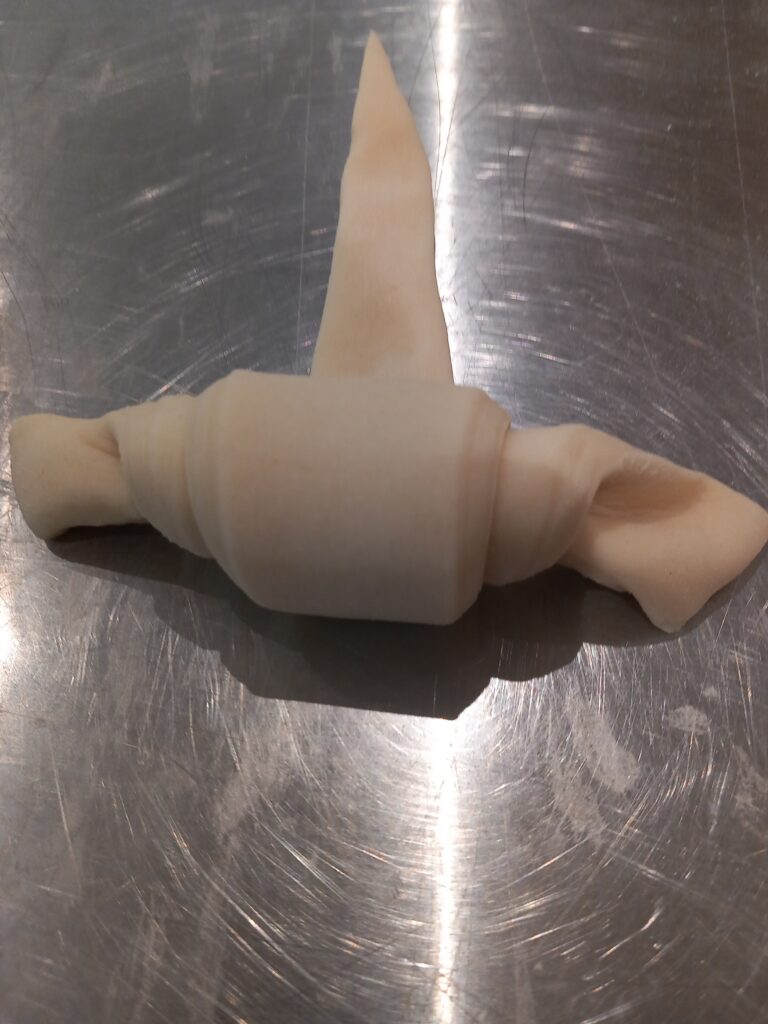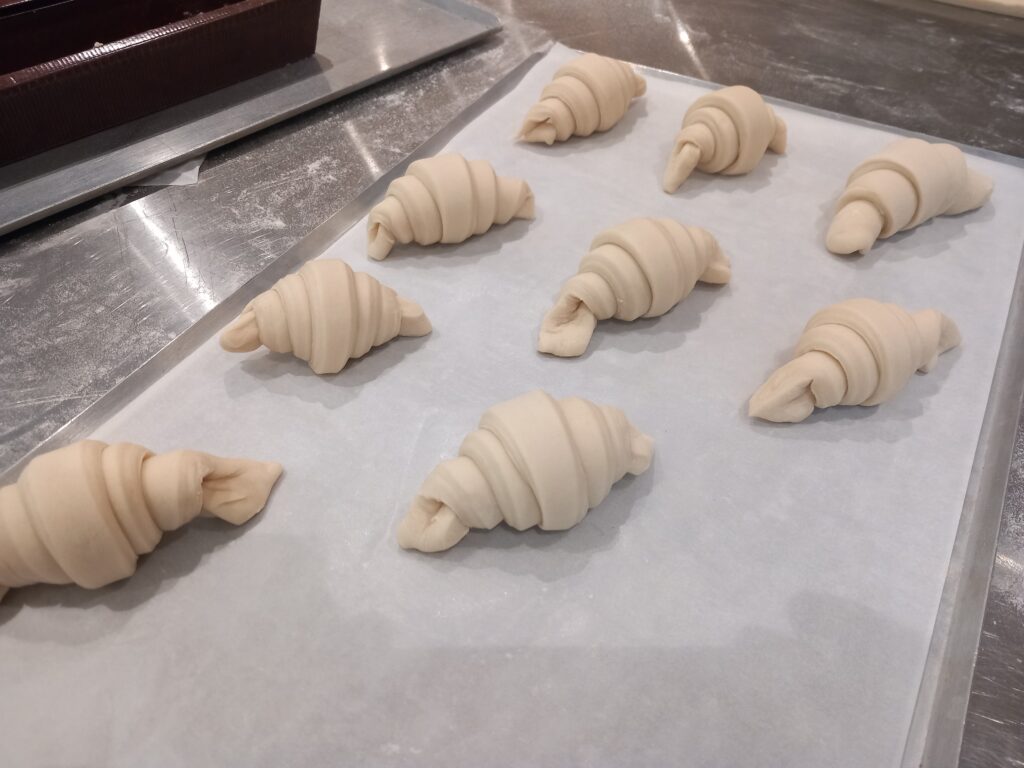The plain butter croissant we enjoy with our morning coffee is widely acclaimed as a French national food treasure, but it actually has its roots in the Austrian capital of Vienna and only migrated to Paris in the first quarter of the 19th century.
They are relatively easy to make, if you have done it before: a little time consuming and on the higher technical difficulty scale of bread making. You can successfully recreate croissants in the home kitchen at a squeeze.
Croissants use the same dough as Danish pastry. What distinguishes them from other sweet, folded breads is the method of rolling them up. The whole secret of croissant making is in the burying of a large amount of butter in your yeast dough and folding the dough in a particular way to give it the layered effect, then letting it rise to its maximum before baking.
Ingredients:
- 500 g bread flour
- 75 g sugar
- 8 g dry yeast
- 5 g salt
- 50 g butter, cubed small
- 8 g baking enhancer
- 1 egg
- 185–200 ml milk, depending on the flour
- 2 g vanilla essence
For making the butter block, or beurrage in French, for folding into the dough:
- 450 g butter
- 50 g bread flour
Egg wash for coating: 2 eggs mixed with a splash of cold water, then sieved to remove the streaks caused by the strands in the egg whites.
Method:
First make your beurrage by placing the butter and bread flour in a bowl. Wear a pair of gloves and squish it all together until completely combined. Spread out a large square of cling wrap, shape the butter block into a square, push it down to around ¼-inch (6 mm) thickness, wrap the block and set it aside outside the fridge.
Using a mixer with a dough-hook attachment, add all the dry ingredients, turn on slow for a minute or two, then increase the speed to medium. Mix the egg and vanilla essence with the milk and start to add slowly. Depending on the flour, the dough could take all the milk or you might have some left. Once the dough is of a consistency you are happy with, add the cubed butter a little at a time. Once the butter has been completely absorbed, mix the dough for at least 7 minutes to allow the gluten net to form within the dough.
Sprinkle a little flour on the bench, turn out the dough and using both hands work in a circular motion to tighten the ball of dough, then return to the mixing bowl to rest for 30 minutes.
The folding process takes a couple of hours, as the dough has to rest for 30 minutes between each fold.
After the dough has rested, slightly dust the work surface and the top of the dough and gently roll out the four edges of the ball until about 3–5 mm thick, leaving a small mound in the centre. You will have to dust on and under the dough to ensure nothing sticks as you go. Once you have these four flaps rolled out, take a small dry brush and dust off any flour on and under the dough. Unwrap the beurrage and place it in the centre on the small mound. Take one of the rolled out flaps of dough, gently stretch it without tearing and completely cover the beurrage and neatly tuck it under on the opposite side. Repeat the same with all the flaps then wrap in cling wrap and place in the fridge.
After 30 minutes, remove it from the fridge, lightly dust the work surface, remove the parcel from cling wrap and dust the top of the dough. The folding prescribed for the butter croissant is 4x, 3x, 4x. The 4x means gently rolling out the dough to 20 cm wide, 40 cm long and 1 cm thick, always ensuring there is no sticking of the dough to the work surface or the rolling pin by constantly dusting both the work surface under the dough and the surface of the dough itself. When rolled out, brush off all flour from the top of the dough and fold both ends to meet in the middle. Brush the flour off again and fold like you are closing a book. Brush excess flour from outside, wrap in cling wrap and return to fridge for 30 minutes to rest. Repeat the process a second time, except only do 3x folds: once rolled out fold back one third then fold the remaining third of the dough back over the first fold, leaving three layers. Always remember to brush off excess flour before and after folding.
Do the final fold of 4x and leave to rest for 30 minutes in the fridge. Remove from the fridge, dust then roll out the dough to a width of 17–18 cm, a length of around 60 cm and around 5–6 mm thick. Brush any excess flour from both sides and gently go around the edges of the dough, lifting it and allowing it to shrink back naturally as the gluten net pulls. Using a pastry cutter make a cut every 7 cm along the edge closest to you, along the outer edge make a cut every 7cm starting 3.5 cm in, to create elongated triangles with a base of around 7 cm and a length of around 14 cm, when cut from the two base points to the apex (see photo).
Once you have cut all the triangles, you can start rolling up the individual croissants. For each triangle, make a cut of 2 cm in the middle of the base, pull the two sides of the base apart and roll. At the same time stretch the tip. Each time you do a roll, stretch the tip: this ensures the dough stays thin and doesn’t get ‘bread-y’ in the middle when baked. As the croissants are made using baking enhancer, they can be either placed on a tray and put in the freezer for another day, or placed on baking paper on an oven tray with distance between them to give them enough space to rise.
The croissants can’t be baked on the same day they are made, but must be left to rise at first outside the fridge and then placed in the fridge to rise over night. Before you place them in the fridge, gently brush each croissant with egg wash. Brush a second time before baking the next day and then allow to rise for an hour.
Place the croissants in a preheated 190°C oven for 18 to 20 minutes. It was worth writing the column to show how much work goes into your morning croissant, but it is probably easier to keep purchasing them from your local bakery.





If you enjoyed this recipe why not share it with your friends via social media or e-mail? If you want a copy of your own select the print option at the top of the page.

